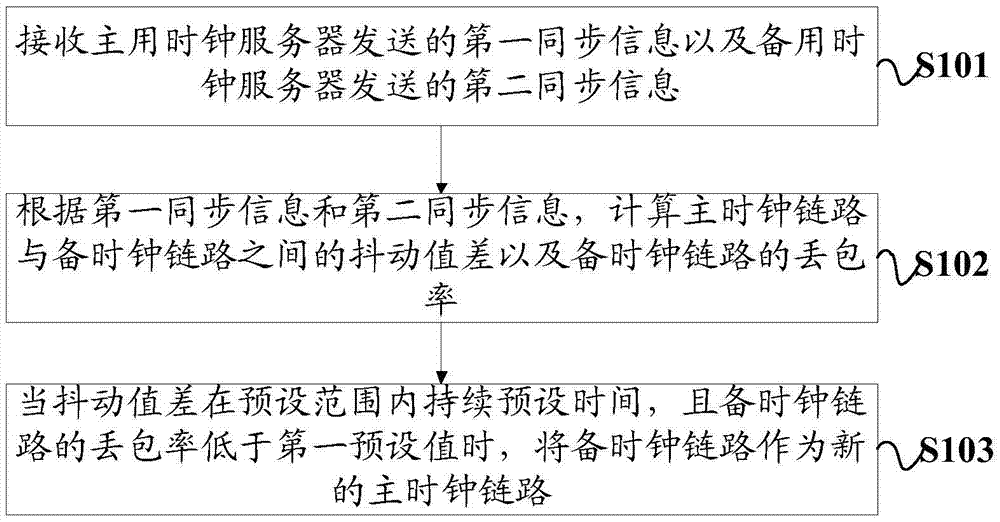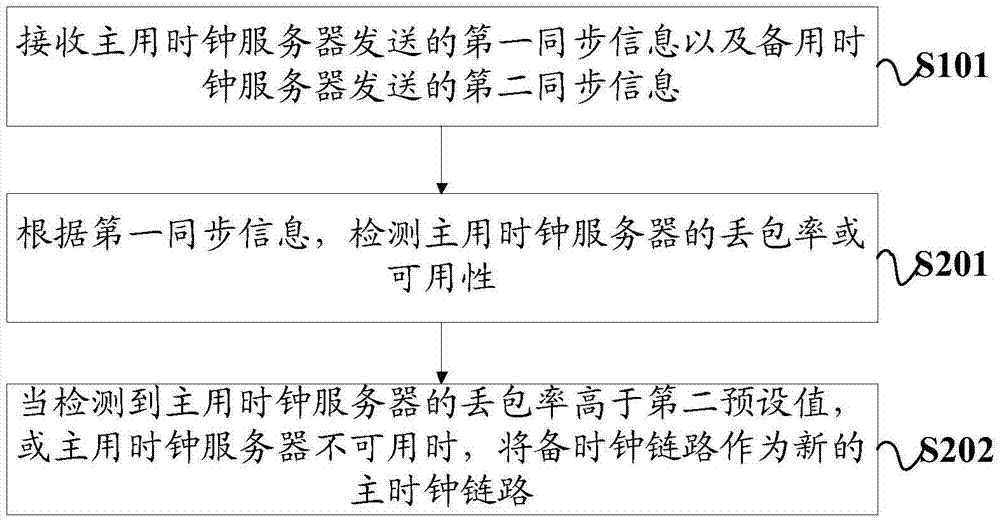Clock link switching method and device and base station
A link switching and link technology, which is applied in synchronization devices, time division multiplexing systems, multiplexing communications, etc., can solve the problems of passive and rigid switching of master and backup clocks, and low accuracy of synchronization data, and saves energy. Switching time, improving synchronization performance, fast and accurate switching effect
- Summary
- Abstract
- Description
- Claims
- Application Information
AI Technical Summary
Problems solved by technology
Method used
Image
Examples
Embodiment 1
[0070] like figure 1 As shown, the embodiment of the present invention provides a clock link switching method, including:
[0071] Step S101: Receive the first synchronization information sent by the active clock server and the second synchronization information sent by the standby clock server.
[0072] The base station establishes different clock links with the active clock server and the standby clock server respectively, and exchanges synchronization information through respective clock links. Among them, the base station receives the first synchronization information sent by the active clock server and feeds back the response information, and performs synchronization information interaction with the active clock server; and the base station does not feed back the response information after receiving the second synchronization information sent by the standby clock server , and the standby clock server is one-way information transmission, and the second synchronization inf...
Embodiment 2
[0079] The first embodiment above introduces the clock link switching method in the scenario where both the active clock server and the standby clock server are available. The following embodiment will further describe it in conjunction with other scenarios.
[0080] Among them, such as figure 2 As shown, after step S101, the clock switching method also includes:
[0081] Step S201: Detect the packet loss rate or availability of the master clock server according to the first synchronization information.
[0082] Wherein, the first synchronization information carries clock level information that can determine whether the clock server is available. Generally, a clock level of 6 means that the clock of the clock server is available, otherwise it is unavailable. In addition, the base station may also calculate the packet loss rate of the master clock link by counting the packet data carried in the first synchronization information.
[0083] Step S202: when it is detected that t...
Embodiment 3
[0086] Embodiment 1 and Embodiment 2 above respectively introduce the clock link switching methods in different scenarios, and the above switching methods will be further explained below in conjunction with the accompanying drawings.
[0087] The first synchronization information includes: an Announce message, a Sync message, and a delayed response message (Delay_Response message), and the second synchronization information includes: an Announce message and a Sync message.
[0088] Specifically, step S102 includes the following steps:
[0089] Calculate the jitter value of the master clock link according to the receiving time and sending time of the first synchronization information within a predetermined time period.
[0090] like image 3 As shown, the master clock server periodically sends a Sync message to the base station, and the Sync message carries sending time information, that is, the sending time of the first synchronization information. The transmission time of t...
PUM
 Login to View More
Login to View More Abstract
Description
Claims
Application Information
 Login to View More
Login to View More - Generate Ideas
- Intellectual Property
- Life Sciences
- Materials
- Tech Scout
- Unparalleled Data Quality
- Higher Quality Content
- 60% Fewer Hallucinations
Browse by: Latest US Patents, China's latest patents, Technical Efficacy Thesaurus, Application Domain, Technology Topic, Popular Technical Reports.
© 2025 PatSnap. All rights reserved.Legal|Privacy policy|Modern Slavery Act Transparency Statement|Sitemap|About US| Contact US: help@patsnap.com



